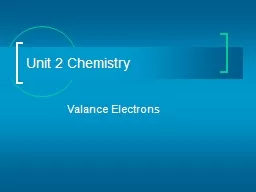/


Valence Electrons Valence electrons are the electrons in the outer energy level of an atom These are the electrons that are transferred or shared when atoms bond together What does it mean to be reactive ID: 643318
Download Presentation The PPT/PDF document "Valance Electrons Unit 2 Chemistry" is the property of its rightful owner. Permission is granted to download and print the materials on this web site for personal, non-commercial use only, and to display it on your personal computer provided you do not modify the materials and that you retain all copyright notices contained in the materials. By downloading content from our website, you accept the terms of this agreement.
Slide1
Valance Electrons
Unit 2 ChemistrySlide2
Valence Electrons
Valence electrons are the electrons in the outer energy level of an atom.
These are the electrons that are transferred or shared when atoms bond together.Slide3
What does it mean to be reactive?
We will be describing elements according to their reactivity.
Elements that are reactive bond easily with other elements to make compounds.
Some elements are only found in nature bonded with other elements. What makes an element reactive?
An incomplete valence electron level.
All atoms (except H and He) want to have 8 electrons in their very outermost energy level (This is called the octet rule.)
Atoms bond until this level is complete. Atoms with less than 4 valence electrons lose them during bonding. Atoms with 6, 7, or 8 valence electrons gain electrons during bonding.Slide4
Elements that have either gained or lost electrons are called ions.
Positively charged:
Cations
Any atom that loses electrons to form compounds are called cations.
Cations
have a positive charge.
Naming
cations
: Use the element name followed by the word “ion”. Slide5
Cation formula
systematic name
common name
Fe
2+
iron(II) ion
ferrous ion
Fe
3+iron(III) ionferric ion Cu1+copper(I) ioncuprous ion Cu2+copper(II) ioncupric ion Hg1+mercury(I) ionmercurous ion Hg2+mercury(II) ionmercuric ion Pb2+lead(II) ionplumbous ion Pb4+lead(IV) ionplumbic ion Sn2+tin(II) ionstannous ion Sn4+tin(IV) ionstannic ion
Table: Metal cations
with more than one common charged form
Slide6
Elements that have either gained or lost electrons are called ions.
Negatively charged:
Anions
Atoms that gain electrons to form compounds are called anions. Anions have a negative charge.Naming Anions: Drop the last few letters of the element name and add “ide
”. Slide7
Electron OrbitalsSlide8
5Slide9Slide10Slide11
Bohr’s Model of the Atom
Electrons orbit the nucleus at a fixed distance.
Each orbit is associated with a definite energy level.
Bohr ModelSlide12
Energy levels are quantized
Electrons travel in orbits around the nucleus
The farther the electron is from the nucleus the more energy it has.Slide13
Bohr Diagrams
These are simple diagrams that show the number of electrons in each orbital of an element.
The symbol of the element is placed in the nucleus, and electrons are then placed in each orbital.
Let’s do a couple of examples.- Si, NSlide14
These diagrams are a combination of a Bohr Diagram and a Rutherford Diagram.
The main difference between this diagram and the Bohr diagram is the inclusion of the # of protons and # of neutrons in the nucleus.
Bohr-Rutherford DiagramsSlide15
How To Draw Bohr-Rutherford Diagrams:
Draw the nucleus as a solid circle.
Put the number of protons (atomic number) in the nucleus with the number of neutrons (atomic mass – atomic number) under it.
Place the number of electrons (same as protons) in orbits around the nucleus by drawing circles around the nucleus.
Remember,
1st shell – 2 electrons, 2nd shell – 8 electrons, 3rd shell – 8 electrons, 4th shell – 18 electrons. Slide16
How To Draw Bohr-Rutherford Diagrams:Slide17
Assignment
Which Atom is Which
Intro. to chemistry